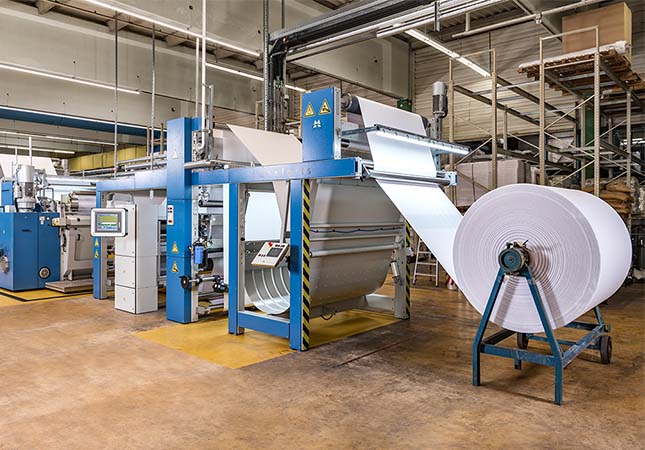How The Automatic Packaging Machine Works
The significance of automatic packaging machine in the textile industry cannot be overstated, as they have transformed the manner in which textile products are prepared for shipping, warehousing, and retail presentation.


Automatic Packaging Machine Origin
l The origin of the automatic packaging machine can be traced back to the industrial revolution when textile manufacturing began to grow rapidly. The need for efficient and automated packing solutions for fabric rolls arose as textile production became more mechanized and the demand for textiles increased.
l Early iterations of fabric roll packing machines were manual and required significant human effort to wrap and pack fabric rolls. However, with advancements in technology and automation, the concept of the automatic packaging machine emerged.
l The development of automatic packaging machine can be attributed to the continuous innovation and improvement in industrial packaging machinery. Over the years, manufacturers have leveraged mechanical, electrical, and software engineering advancements to create automated packing machines that can handle fabric rolls of various sizes, lengths, and quantities, while increasing productivity and reducing labor costs.
l Today, the automatic packaging machine is widely used in textile manufacturing and related industries to streamline the packing process, ensure consistent packing quality, and enhance efficiency in handling fabric rolls for transportation and storage.

How the Automatic Packaging Machine Works
An automatic packaging machine typically operates through a series of steps to efficiently and effectively wrap fabric rolls for transportation and storage, here is a general overview of how an automatic packaging machine works.
1. Fabric Roll Loading
Fabric rolls are loaded onto the machine's feeding mechanism, which can be a conveyor or a series of rollers. The rolls are positioned in the desired orientation for wrapping, with the fabric end aligned properly.
2. Wrapping Material Dispensing
The machine dispenses a roll of wrapping material, which can be a plastic film, shrink wrap, or other suitable materials, from a roll or a reel.
3. Wrapping Process Initiation
The machine starts the wrapping process, where the wrapping material is pulled around the fabric roll, typically using rotating rollers or arms, while the fabric roll rotates to ensure even wrapping.
4. Wrapping Material Sealing and Cutting
Once the wrapping material has been fully wrapped around the fabric roll, the machine seals the edges of the material together, typically using heat or adhesive, to secure the wrap. The excess material is then cut, leaving a neatly wrapped fabric roll.
5. Optional Additional Features
Depending on the specific design and features of the machine, additional functionalities may be included, such as label application, stretch film tension control, or printing of labels or barcodes for identification and tracking purposes.
6. Fabric Roll Unloading
The wrapped fabric roll is then released from the machine's feeding mechanism, and it can be manually or automatically unloaded from the machine for transportation or storage.
7. Control and Monitoring
Throughout the wrapping process, the machine's control system monitors and controls various parameters, such as wrapping tension, material dispensing, sealing, and cutting, to ensure consistent and reliable wrapping quality.
SUNTECH ST-ARPM (Automatic Packaging Machine)
By using clear and concise language, and avoiding repetition, the list format provides a more organized and easily understandable overview of the features of the ST-ARPM automatic packaging machine.
1. Vacuum & Automatic Packing
The machine is designed to pack fabric rolls in a vacuum and fully automatic manner, reducing the need for manual labor and ensuring an efficient and streamlined packing process.
2. European CE Standard Certified
The machine meets the quality standards of European CE (Conformité Européene) certification, ensuring reliable performance and compliance with industry regulations.
3. Warranty Extension Available
Suntech offers warranty extension options for the ST-ARPM, providing added peace of mind and support to customers beyond what other suppliers may offer.
4. Material Saving
The machine utilizes advanced technology that allows for material savings compared to traditional plastic bag packing methods, reducing waste and optimizing resource utilization.
5. Vacuum Packing Effect
The ST-ARPM creates a vacuum packing effect, ensuring that the fabric rolls are tightly packed and protected during transportation and storage.
6. Full Automation
The machine operates in a fully automated manner, minimizing the need for manual intervention and reducing labor force requirements, thereby increasing productivity and efficiency.
Conclusion
knowing the origin of the automatic packaging machine could help us more familiar with the machine, and it is important to know the exact working process of the automatic packaging machine. We can foresee that the automatic packaging machine would be more intelligent and widely used in the future.
As a reputable textile machinery manufacturer with a rich history in automation and intelligent manufacturing technology of textile and warehousing equipment, SUNTECH Textile Machinery possesses cutting-edge core technologies that are recognized globally.
SUNTECH’s products cover the textile manufacturing and handling process of almost fabric types, in which pinking machine, non woven machine, beam truck, meltblown machine, fabric cutting machine, motorized beam trolley, beam storage, warp tying machine are the most popular machines and material handling equipment.
SUNTECH Textile Machinery leads the textile industry with our innovation and experience! Quotes and Cooperation are Highly Welcome!
评论
发表评论